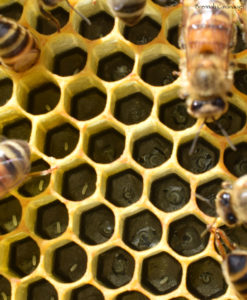I recently got a couple new colonies of honey bees. These were nucleus colonies, which are just tiny honey bee colonies in small (and more portable) boxes. They rapidly outgrow such small boxes, so moving them into new boxes (and looking them over and taking photos while I was at it) was my first task. Here’s a bit of what I encountered.

The black background to these photos is foundation, a template that the bees construct their comb on inside the hive. Foundation is a sheet of wax, or plastic (or wax coated plastic) printed with a hexagon pattern that the bees draw out into comb. In this case it is black plastic, which is often helpful for beginners to be able to see the bee eggs and young larvae, which is useful in assessing the health of the colony. (You actually literally have to train your eyes to see them; I had good eyesight and knew what I was looking for when I started, but I simply wasn’t able to see them through my veil so I would take it off temporarily. Now I can see them just fine through my veil.)





This is so exciting!